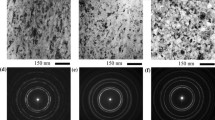Abstract
Grain boundary character distribution is a relatively new microstructural feature that describes the proportions of random and special grain boundaries as defined by the coincident site lattice model. The combination of the availability of a new experimental technique based on the automatic indexing of backscatter Kikuchi electron diffraction patterns in the scanning electron microscope (orientation imaging microscopy) and reports in the literature describing the optimization of the grain boundary character distribution through thermomechanical processing are making the potential for enhanced materials properties in commercial metals and alloys a reality. Although the effects of optimizing the grain boundary character distribution in the cost-effective improvement of properties have been documented, the potential for commercialization has limited the disclosure of processing details. In this article, two separate approaches to the optimization of the grain boundary character distribution in oxygen-free electronic copper at Lawrence Livermore National Laboratory are discussed.
Similar content being viewed by others
References
P. Lin et al., “Influence of Grain Boundary Character Distribution on Sensitization and Intergranular Corrosion of Alloy 600,” Scripta Metalurgica et Materialia, 33 (9) (1995), pp. 1387–1392.
G. Palumbo and K.T. Aust, “Solute Effects in Grain Boundary Engineering,” Canadian Metallurgical Quarterly, 34 (3) (1995), pp. 165–173.
G. Palumbo et al., “Grain Boundary Design and Control for Intergranular Stress-Corrosion Resistance,” Scripta Metallurgica et Materialia, 25 (8) (1991), pp. 1775–1780.
G. Palumbo et al., “Grain Boundary Engineering for Intergranular Fracture and Creep Resistance,” Proceedings of Microscopy and Microanalysis ’96 (San Francisco, CA: San Francisco Press, 1996) pp. 362–363.
E.M. Lehockey et al., “Grain Boundary Engineered Lead Alloys,” Mat. Res. Soc. Symp. Proc., 458 (Pittsburgh, PA: MRS, 1997), pp. 243–248.
T. Watanabe, “An Approach to Grain Boundary Design for Strong and Ductile Polycrystals,” Res. Mech., 11 (1984), pp. 47–84.
H. Grimmer, W. Bollmann, and D.H. Warrington, “Coincidence-Site Lattices and Complete Pattern-Shift Lattices in Cubic Crystals,” Acta Cryst., 30A (1974), pp. 197.
G. Palumbo et al., “A Grain Boundary Engineering Approach to Materials Reliability,” Mat. Res. Soc. Symp. Proc., 458 (Pittsburgh, PA: MRS, 1997), pp. 273–282.
B.L. Adams, “Orientation Imaging Microscopy—Application to the Measurement of Grain Boundary Structure,” Materials Science and Engineering A-Structural Materials Properties Microstructure and Processing, 166 (1–2) (1993), pp. 59–66.
B.L. Adams, S.I. Wright, and K. Kunze, “Orientation Imaging—The Emergence of a New Microscopy,” Met. Trans. A, 24 (4) (1993), pp. 819–831.
R.D. Doherty, I. Samajdar, and K. Kunze, “Orientation Imaging Microscopy—Application to the Study of Cube Recrystallization Texture in Aluminum,” Scripta Metallurgica et Materialia, 27 (11) (1992), pp. 1459–1464.
T.A. Mason and B.L. Adams, “The Application of Orientation Imaging Microscopy,” JOM, 46 (10) (1994), pp. 43–45.
W.E. King and A.J. Schwartz, “Toward Optimization of the Grain Boundary Character Distribution in OFE Copper,” Scripta Materialia, in press.
W.E. King and A.J. Schwartz, “Toward Optimization of the Grain Boundary Character Distribution in Copper by Strain Annealing,” Mat. Res. Soc. Symp. Proc., 458 (Pittsburgh, PA: MRS, 1997), pp. 53–60.
K.L. Merkle and D. Wolf, “Structure and Energy of Grain Boundaries in Metals,” MRS Bulletin, 15 (9) (1990), pp. 42–50.
V. Randle, The Measurement of Grain Boundary Geometry (London: IOP Publishing Ltd, 1993).
D.G. Brandon, “The Structure of High-Angle Grain Boundaries,” Acta Metall, 14 (1966), p. 1479.
W.T. Reed and Shockley, “Dislocation Models of Grain Boundaries,” Phys. Rev., 78 (1950), pp. 275–289.
B.L. Adams, J. Zhao, and H. Grimmer, “Discussion of the Representation of Intercrystalline Misorientation in Cubic Materials,” Acta Crystallographica Section A-Foundations of Crystallography, 46 (1990), pp. 620–622.
G. Palumbo and K.T. Aust, “Structure-Dependence of Intergranular Corrosion in High Purity Nickel,” Acta Metallurgica et Materialia, 38 (1990), p. 2343.
P.H. Pumphrey, Grain Boundary Structure and Properties, ed. G.A. Chadwick and D.A. Smith (New York: Academic Press, 1976), p. 139.
Y. Ishida and M. McLean, “Burgers Vectors of Boundary Dislocations in Ordered Grain Boundaries of Cubic Metals,” Phil. Mag., 27 (1973), p. 1125.
V. Rybin and A.A. Zisman, Poverhnost’, 1 (1982), p. 87.
L.S. Shvindlerman and B.B. Straumal, “Regions of Existence of Special and Non-Special Grain Boundaries,” Acta Metallurgica, 33 (9) (1985), pp. 1735–1749.
V. Randle, private communication, April 1997.
C.B. Thompson and V. Randle, “Towards Optimization of Grain-Boundary Structures in Annealed Nickel,” Proceedings of 1996 MSA Annual Meeting (San Francisco, CA: San Francisco Press, 1996), pp. 356–357.
Orientation Imaging Microscopy Software Version 2.0 User Manual (Provo, UT: TSL, 1996), pp. 3–5.
V. Randle and B. Ralph, “Applications of Grain Boundary Engineering to Anomalous Grain Growth,” Mat. Res. Soc. Symp. Proc., 122 (Pittsburgh, PA: MRS, 1988), pp. 419–424.
V. Randle and A. Brown, “Development of Grain Misorientation Texture, in Terms of Coincident Site Lattice Structures, as a Function of Thermomechanical Treatments,” Philosophical Magazine, A59 (5) (1989), pp. 1075–1089.
G. Palumbo et al., “On Annealing Twins and CSL Distributions in F.C.C. Polycrystals,” Phys. Stat. Sol., 131 (1992), pp. 425–428.
J.W. Rutter and K.T. Aust, “Migration of 〈100〉 Tilt Grain Boundaries in High Purity Lead,” Acta Metallurgica, 13 (1965), pp. 181–186.
K.T. Aust and J.W. Rutter, “Grain Boundary Migration in High-Purity Lead and Dilute Lead-Tin Alloys,” Trans. AIME, 215 (1959), p. 119.
K.T. Aust and J.W. Rutter, “Temperature Dependence of Grain Migration in High-Purity Lead Containing Small Additions of Tin,” Trans. AIME, 215 (1959), p. 820.
Author information
Authors and Affiliations
Additional information
Adam J. Schwartz earned his Ph.D. in metallurgical engineering from the University of Pittsburgh in 1991. He is currently a staff scientist in the Chemistry and Materials Science Directorate at the Lawrence Livermore National Laboratory.
Wayne E. King earned his Ph.D. in materials science and engineering from Northwestern University in 1979. He is currently group leader of interface sciences in the Chemistry and Materials Science Directorate at the Lawrence Livermore National Laboratory.
Rights and permissions
About this article
Cite this article
Schwartz, A.J. The potential engineering of grain boundaries through thermomechanical processing. JOM 50, 50–55 (1998). https://doi.org/10.1007/s11837-998-0250-5
Issue Date:
DOI: https://doi.org/10.1007/s11837-998-0250-5




